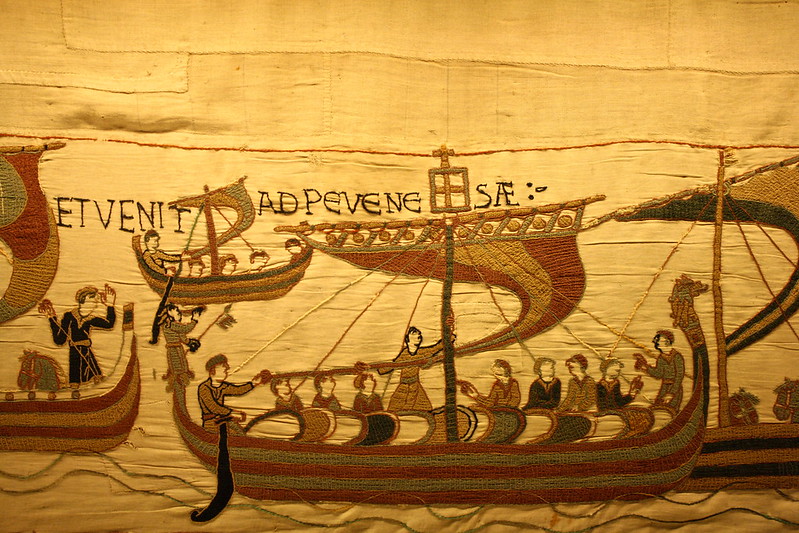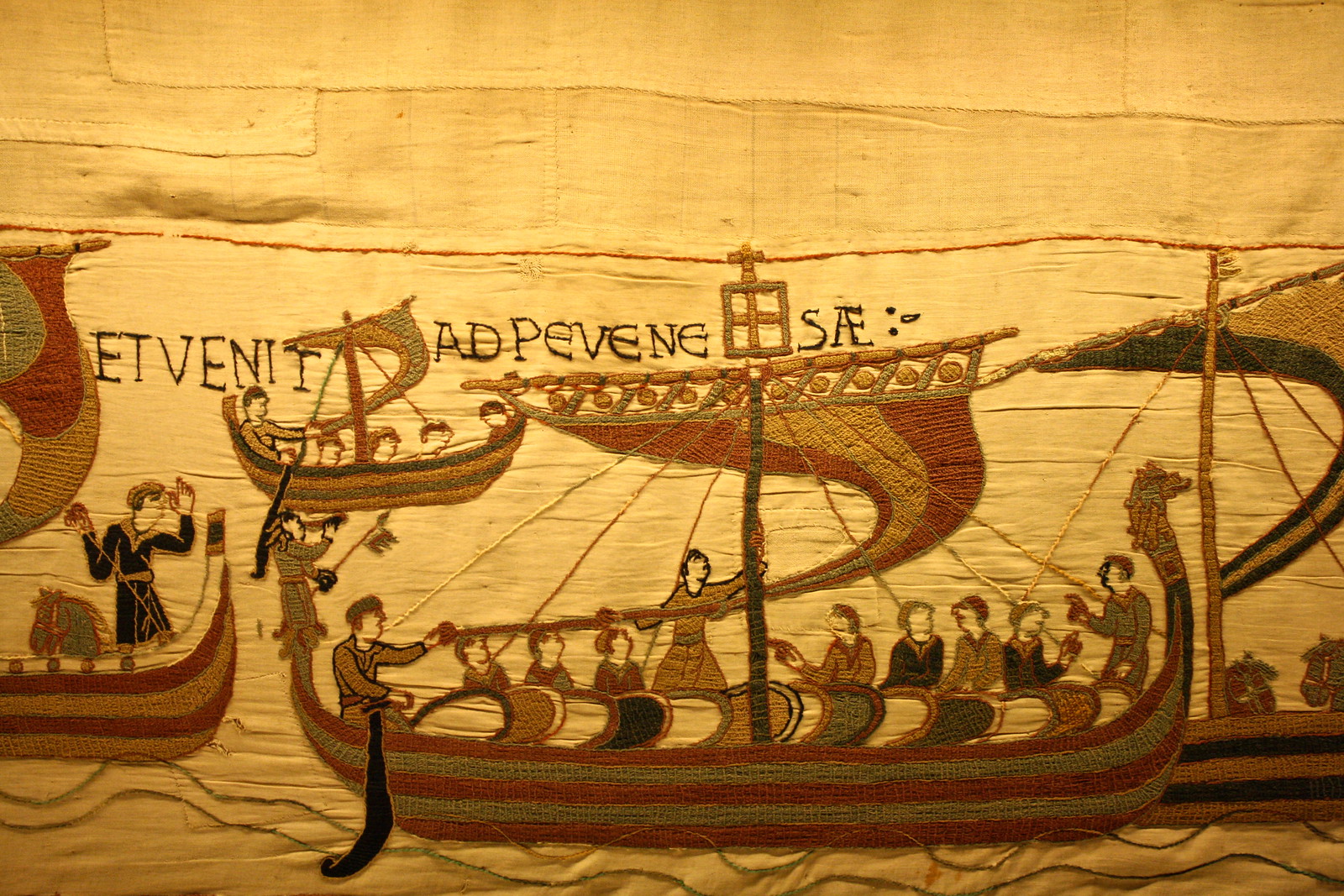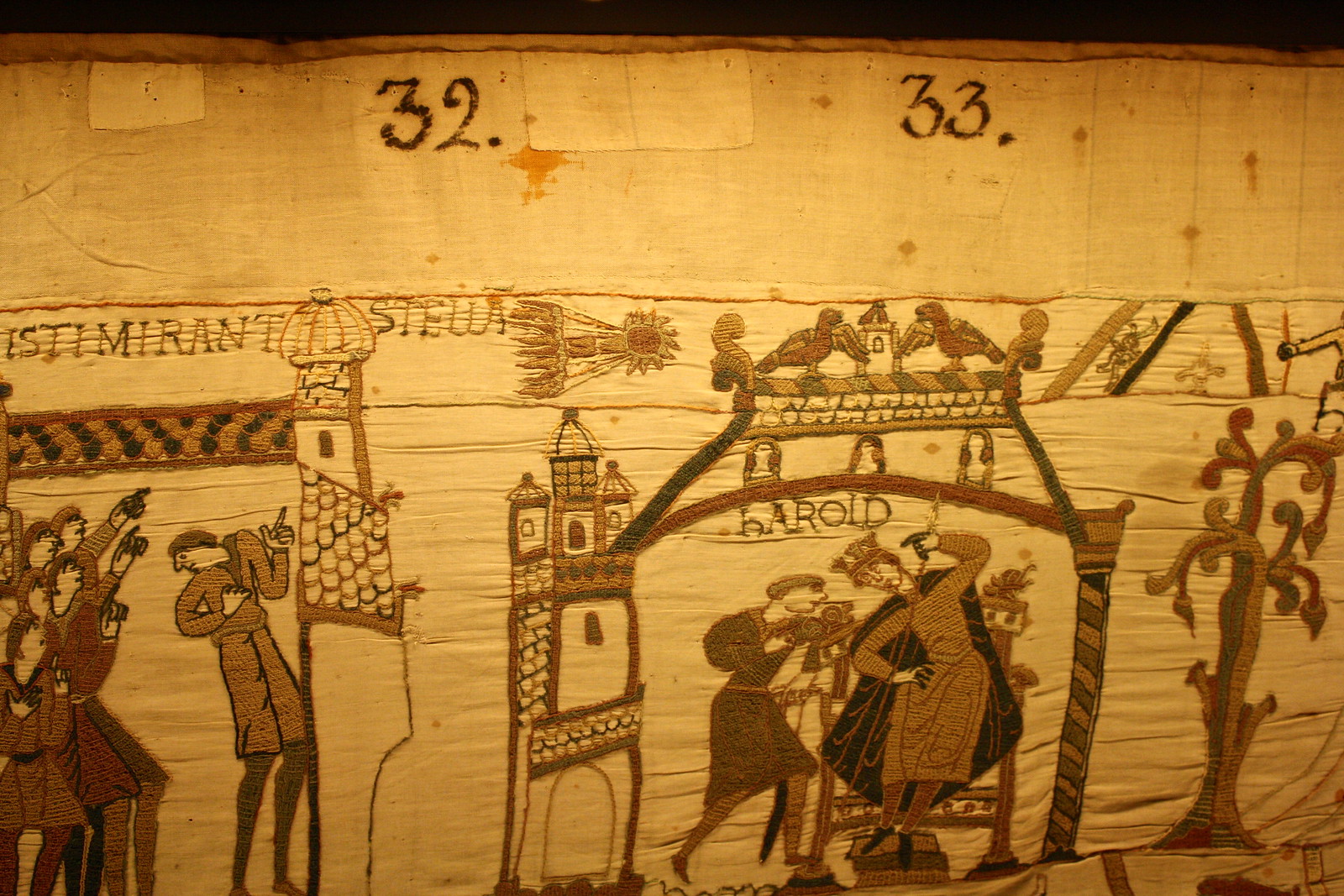Bayeux, France: Home to a Story-Telling Tapestry
After spending four days in Paris over Christmas, I was ready to leave the big city and experience life in the French countryside; lots of people I talked to before leaving for Christmas vacation told me that the provinces were just as good, if not better, than Paris. While planning for the trip, I didn’t really know what exactly there was to see outside of Paris, but one thing I did know out there was the Bayeux Tapestry, viewable two hours northwest of Paris just off the coast of Normandy.
I don’t think the tapestry would ever make it into Lonely Planet’s “Top Experiences” section, but since I’m a history major, I fully embraced my nerdiness and set off to see it.
So what is this tapestry? Well, it’s a huge, 230-foot piece of linen fabric embroidered with scenes that depict the events leading up to the time when the Normans (invaders from Scandinavia who settled in northern France—Normandy—and became French), led by Duke William, crossed the English Channel in 1066 and invaded England to depose King Harold Godwinson.
You see, William claimed that the crown should have passed to him when Harold’s predecessor, Edward the Confessor, passed away in 1065. After all, he said, King Edward had promised him that he would be his heir. However, Harold had a counter-claim that Edward had promised him the kingdom on his deathbed. Plus, he was the Earl of Wessex, the second-most-powerful man in the country. And since he was already in London when Edward died, the witan—or Anglo-Saxon council of noblemen who chose the king’s successor—met the day after Edward’s death and elected Harold king of England. Obviously, William was not too thrilled about their decision, and made plans to invade, plans that culminated in the Battle of Hastings and Harold’s death in 1066.
And that’s the story the tapestry tells us through 58 scenes with gel-pen-like yarns that are still vibrant after almost a thousand years, the story of how William the Bastard became William the Conqueror.
So why was it made in the first place? It was assembled to remind the people of Normandy about the recent turn of events that made their duke King of England. The tapestry used to hang all the way around the nave of the Bayeux cathedral, (presumably) just above the arches, functioning in the same way stained glass did for an illiterate population but with more political than religious teaching.
At some point in time, it was taken down and simply folded up and kept in a chest. At other points, it was exhibited in various locations around the area. Today, it is safely displayed in a long, dim semicircular room in a museum in the city of Bayeux (pronounced “bah-yuh” [ba.jø]). The museum gave some great context to medieval life and the historical context surrounding the events of the Norman invasion, and the free audioguide made the pictures and Latin text feel like an exciting, read-it-in-one-night novel. (Although to be honest, I was able to read the Latin with what little remains from my high-school-era Latin.) The narrator was at times a little sassy, saying, for example that the armor-clad Norman bishop in one of the scenes wielded a mace because, although he was forbidden to kill, he was allowed to “bludgeon.”
From Bayeux I took the train to Saint-Malo in neighboring Brittany, my home base for visiting Mont-Saint-Michel and the old walled city of Saint-Malo proper. I had gotten the younger-than-26 discount on the morning trip from Paris to Bayeux with no issues, but when the conductor came by to check my discounted ticket on the train to Saint-Malo, he asked to see my carte jeune, or European Youth Card. I had no idea I needed that specific card (not just proof I was “young”) when I went to the ticket machine, so I nervously showed my Spanish residence card. It wasn’t going to work for him. Crap!
Thank God there was a girl sitting across from me who was able to translate between English and French. She explained I needed to have an official card to get train discounts (ugh) but that the conductor was going to let it pass…“this time” (yay!). “Merry Christmas!” he said. What a relief!
What has been the nerdiest place you’ve ever visited—can be historical or even related to a movie or a book? Have you ever been confronted on (or even thrown off) a train for having the wrong ticket? Comment in the thread below!

I don’t think the tapestry would ever make it into Lonely Planet’s “Top Experiences” section, but since I’m a history major, I fully embraced my nerdiness and set off to see it.
 |
| Bayeux Tapestry, scene 38 |
So what is this tapestry? Well, it’s a huge, 230-foot piece of linen fabric embroidered with scenes that depict the events leading up to the time when the Normans (invaders from Scandinavia who settled in northern France—Normandy—and became French), led by Duke William, crossed the English Channel in 1066 and invaded England to depose King Harold Godwinson.
 |
| Bayeux Tapestry, scenes 32 & 33 |
You see, William claimed that the crown should have passed to him when Harold’s predecessor, Edward the Confessor, passed away in 1065. After all, he said, King Edward had promised him that he would be his heir. However, Harold had a counter-claim that Edward had promised him the kingdom on his deathbed. Plus, he was the Earl of Wessex, the second-most-powerful man in the country. And since he was already in London when Edward died, the witan—or Anglo-Saxon council of noblemen who chose the king’s successor—met the day after Edward’s death and elected Harold king of England. Obviously, William was not too thrilled about their decision, and made plans to invade, plans that culminated in the Battle of Hastings and Harold’s death in 1066.
And that’s the story the tapestry tells us through 58 scenes with gel-pen-like yarns that are still vibrant after almost a thousand years, the story of how William the Bastard became William the Conqueror.
 |
| Nave, Bayeux Cathedral |
So why was it made in the first place? It was assembled to remind the people of Normandy about the recent turn of events that made their duke King of England. The tapestry used to hang all the way around the nave of the Bayeux cathedral, (presumably) just above the arches, functioning in the same way stained glass did for an illiterate population but with more political than religious teaching.
At some point in time, it was taken down and simply folded up and kept in a chest. At other points, it was exhibited in various locations around the area. Today, it is safely displayed in a long, dim semicircular room in a museum in the city of Bayeux (pronounced “bah-yuh” [ba.jø]). The museum gave some great context to medieval life and the historical context surrounding the events of the Norman invasion, and the free audioguide made the pictures and Latin text feel like an exciting, read-it-in-one-night novel. (Although to be honest, I was able to read the Latin with what little remains from my high-school-era Latin.) The narrator was at times a little sassy, saying, for example that the armor-clad Norman bishop in one of the scenes wielded a mace because, although he was forbidden to kill, he was allowed to “bludgeon.”
 |
| Bayeux Tapestry, scene 57 |
From Bayeux I took the train to Saint-Malo in neighboring Brittany, my home base for visiting Mont-Saint-Michel and the old walled city of Saint-Malo proper. I had gotten the younger-than-26 discount on the morning trip from Paris to Bayeux with no issues, but when the conductor came by to check my discounted ticket on the train to Saint-Malo, he asked to see my carte jeune, or European Youth Card. I had no idea I needed that specific card (not just proof I was “young”) when I went to the ticket machine, so I nervously showed my Spanish residence card. It wasn’t going to work for him. Crap!
Thank God there was a girl sitting across from me who was able to translate between English and French. She explained I needed to have an official card to get train discounts (ugh) but that the conductor was going to let it pass…“this time” (yay!). “Merry Christmas!” he said. What a relief!
What has been the nerdiest place you’ve ever visited—can be historical or even related to a movie or a book? Have you ever been confronted on (or even thrown off) a train for having the wrong ticket? Comment in the thread below!


